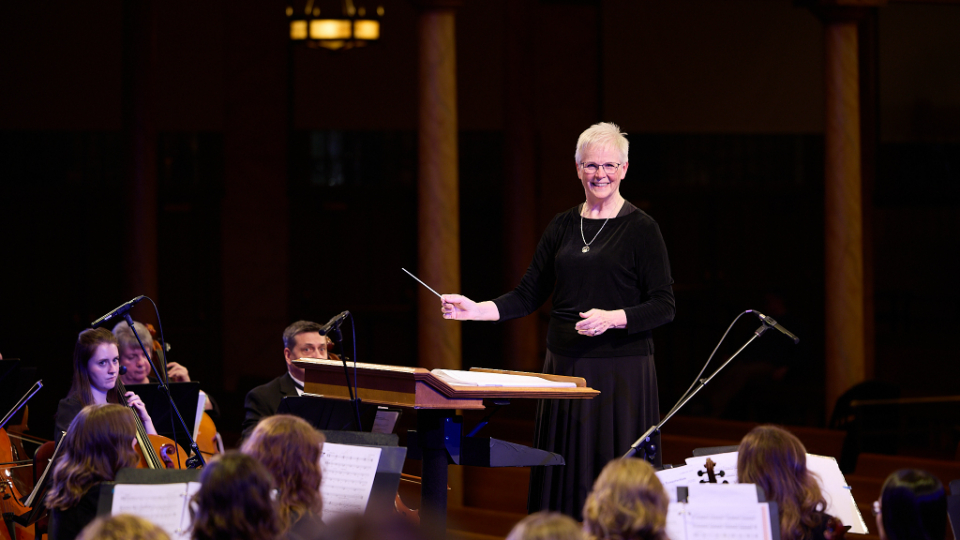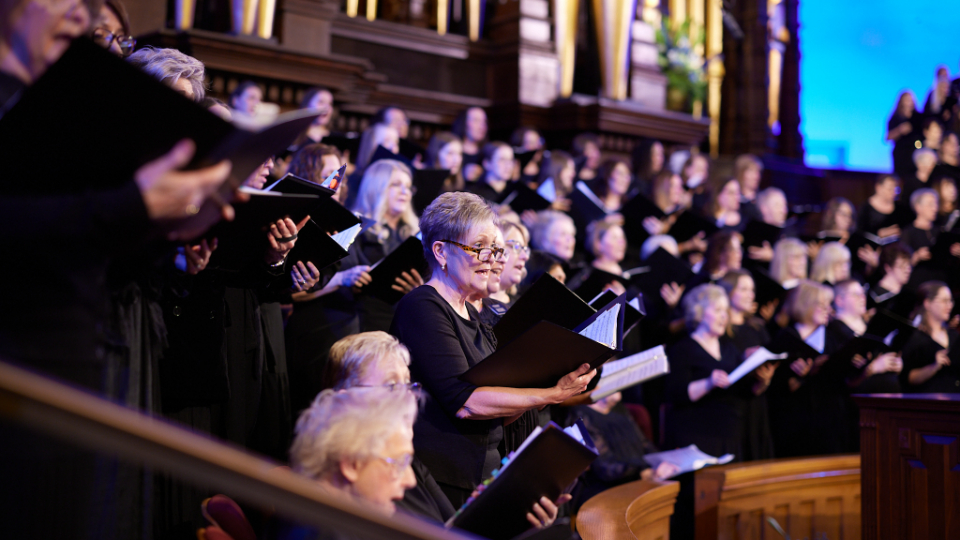Rob Gardner’s first experience writing music about the life of Jesus Christ came in the late 1990s. He was commissioned by his mission president in France to compose a 45-minute work to help broaden the appeal of their gospel message.
The experience was wonderful. But Gardner could only spend about 10 minutes on the Atonement Christ accomplished at the end of His life.
For the next decade, thoughts percolated in Gardner’s mind about doing more and “telling the story in a way that I hadn’t already seen 1,000 times.”
The epiphany came in 2009. Gardner was four months into a graduate school program in scoring music for motion pictures and television at the University of Southern California in Los Angeles. As he studied with gifted students and worked with some of the world’s best musicians, he found his idea: Tell the story of the Savior of the world through the eyes of the people who surrounded Him.
Gardner emailed the London Symphony Orchestra — famous for their soundtracks on “Star Wars,” “Indiana Jones,” “Harry Potter” and other films — about recording the music he would write. They said they had some open dates six months later, and he wrote toward that deadline.
Thus the “Lamb of God” oratorio was born.
-
- Lamb-of-God---Davis-Interfaith-Choir-and-Symphony
- Lamb-of-God---Davis-Interfaith-Choir-and-Symphony
- Lamb-of-God---Davis-Interfaith-Choir-and-Symphony
- Lamb-of-God---Davis-Interfaith-Choir-and-Symphony
- Lamb-of-God---Davis-Interfaith-Choir-and-Symphony
- Lamb-of-God---Davis-Interfaith-Choir-and-Symphony
- Lamb-of-God---Davis-Interfaith-Choir-and-Symphony
- Lamb-of-God---Davis-Interfaith-Choir-and-Symphony
- Lamb-of-God---Davis-Interfaith-Choir-and-Symphony
- Lamb-of-God---Davis-Interfaith-Choir-and-Symphony
- Lamb-of-God---Davis-Interfaith-Choir-and-Symphony
- Lamb-of-God---Davis-Interfaith-Choir-and-Symphony
- Lamb-of-God---Davis-Interfaith-Choir-and-Symphony
- Lamb-of-God---Davis-Interfaith-Choir-and-Symphony
- Lamb-of-God---Davis-Interfaith-Choir-and-Symphony-
- Lamb-of-God---Davis-Interfaith-Choir-and-Symphony
- Lamb-of-God---Davis-Interfaith-Choir-and-Symphony
- Lamb-of-God---Davis-Interfaith-Choir-and-Symphony
- Lamb-of-God---Davis-Interfaith-Choir-and-Symphony
- Lamb-of-God---Davis-Interfaith-Choir-and-Symphony-
- Lamb-of-God---Davis-Interfaith-Choir-and-Symphony
| Temple Square is always beautiful in the springtime. Gardeners work to prepare the ground for General Conference. © 2012 Intellectual Reserve, Inc. All rights reserved. | 1 / 2 |
Fittingly, this production about the final days of Christ’s life through His Resurrection is — from its inception to completion — all about the hope that is found only in Christ.
“I would never want someone to be discouraged, including myself, from continuing to write something because it doesn’t come quickly,” Gardner said. “[Six months] sounds fast, but there were months that went by without me having a single idea. It wasn’t really until [a few months] before the deadline that I really started making strides. It was a struggle for sure.”
The “Lamb of God” communicates hope even in the darkest moments of Christ’s life.
“I wanted to make sure that in every moment of darkness there was also a ray of hope,” Gardner said. “The darkest moment of all would be the Crucifixion. And I wanted the brightest hope in that moment, too.”
The song at that part of the program is called “Here Is Hope.”
 Download Photo
Download PhotoSince the “Lamb of God” was first performed in Arizona (Gardner’s home state) in September 2010, many around the world of different faiths — and some of no faith — have been captivated by its beauty and light. From the first performance, Gardner said, people have been asking to perform it themselves around the world. They released the music to allow people to do that. But they did not release the recorded orchestral tracks.
“I’ve always felt that a choir with a piano is more powerful than a choir with a digital track behind them,” Gardner said. “It required all these groups to go beyond what they would normally do and seek in the community players of instruments who may or may not be part of their faith or who might not be prone to volunteer.”
It created a challenge similar to what Gardner experienced in writing the “Lamb of God.”
“It was like, ‘We’re gonna have to up our game, we’re gonna have to struggle and make this a real thing to put on,’” he said. “Pretty early on, people started performing it. And I started going out there at their invitation to experience it with them. And it just kind of became this viral thing pretty quickly.”
Each year, Gardner estimates that more than 4,000 performers across the world participate in locally produced performances of “Lamb of God” in places as far-reaching as Buenos Aires, Romania, and Taiwan. These performances play for a total audience of more than 50,000 people. Almost all performers are volunteers. In the coming month, performances will take place in Arkansas, California, Colorado, Idaho, Indiana, Montana, Oregon, Taiwan, Washington, Wyoming and Utah, among others.
One such performance took place in the Tabernacle on Temple Square on Friday and Saturday, March 22–23, 2024, by the Davis Interfaith Choir and Symphony. The event marked the beginning of Holy Week.
“Singing in the Tabernacle is quite an experience, and conducting this ensemble here has been just a remarkable lifetime experience,” said Jane Fjeldsted, who conducted the concerts. “The most impact that I’ve seen has been the power of this music on the people who are preparing it and present the concert. The music is magnificent, and the people who perform this and prepare it have come with their deep, abiding testimonies and their faith in Jesus Christ and their love for Him.”
- Lamb-of-God---Davis-Interfaith-Choir-and-Symphony
- Lamb-of-God---Davis-Interfaith-Choir-and-Symphony
- Lamb-of-God---Davis-Interfaith-Choir-and-Symphony
- Lamb-of-God---Davis-Interfaith-Choir-and-Symphony
- Lamb-of-God---Davis-Interfaith-Choir-and-Symphony
- Lamb-of-God---Davis-Interfaith-Choir-and-Symphony
- Lamb-of-God---Davis-Interfaith-Choir-and-Symphony
| Temple Square is always beautiful in the springtime. Gardeners work to prepare the ground for General Conference. © 2012 Intellectual Reserve, Inc. All rights reserved. | 1 / 2 |
For Pastor Bernabe Gonzalez of Utah’s Iglesia Evangelica Christiana Espiritual, the oratorio has a special power in bringing people together.
“I believe we all have a common denominator in all this,” Pastor Gonzalez said. “Our desire wholeheartedly is to serve God and serve the people and love God, love the people. And we need to show it by coming together.”
“We are one church, really, in spite of being different churches, one body of Christ,” said Father Andrzej Skrzypiec of St. Olaf Catholic Church in Bountiful, Utah. “That’s what He wanted. And that’s what we are celebrating here.”
Jack Eggington, who narrated the weekend concerts, said it is important that Gardner tells the story through the eyes of Christ’s followers.
“It helps you identify with the people in the story,” Eggington said. “It keeps us focused, I think, on what is central to our happiness and to our hope, any hope that we have in our lives — and that is the Savior.”
Gardner said his greatest desire for anyone who sees the “Lamb of God” is that they come away feeling hope.
 Download Photo
Download Photo“Hope is the most powerful and essential force in the universe,” Gardner said. “Without it, we have no motivation to get up in the morning, we have no imagination that things can be better and that life can improve and that there’s something to strive for. It’s always the saddest to me when people lose hope. [Christ’s early followers] could have lost hope entirely [at their Messiah’s death]. For three days they sat in that. They must not have lost hope somehow. That’s what I hope for people, is that they feel that.
“If they feel hope, they will take action in whatever way is best suited to them.”